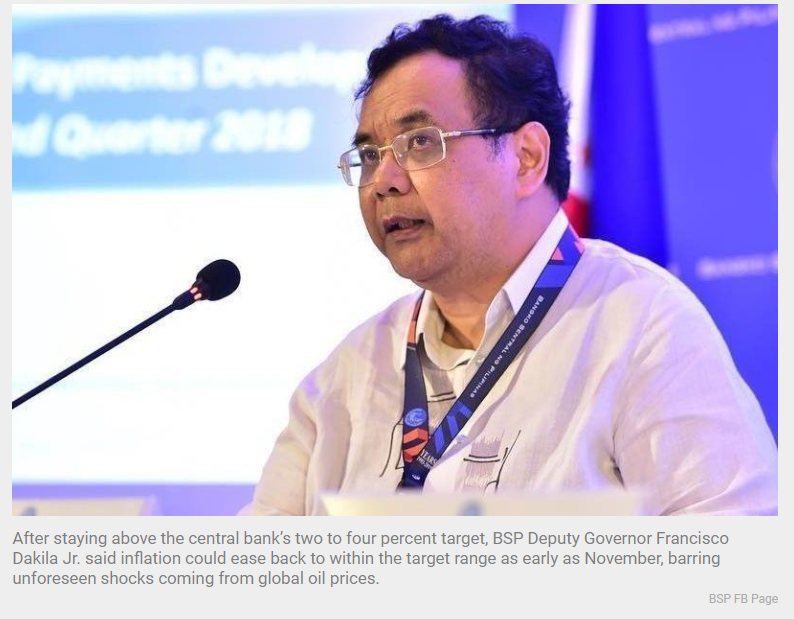Philippines: Inflation seen easing despite IMF concern
MANILA, Philippines — The Bangko Sentral ng Pilipinas (BSP) and economists expect inflation easing toward the end of the year until next year despite the warning of the International Monetary Fund (IMF) that elevated consumer prices could hang around longer in some countries.
After staying above the central bank’s two to four percent target, BSP Deputy Governor Francisco Dakila Jr. said inflation could ease back to within the target range as early as November, barring unforeseen shocks coming from global oil prices.
“We have quite significant base effects operating on inflation in the next few months and this will serve to drive the inflation rate significantly downward. So it’s possible that inflation can return to within the two to four percent target in November and then further decelerate,” Dakila said.
He said inflation could even decelerate below the midpoint of the BSP’s two to four percent target in the first quarter of 2022 due to negative base effects, as well as the moderation in both global oil and non-oil prices.
Inflation averaged 4.5 percent from January to October, as it continues to exceed the central bank target range due to supply shocks, including the impact of weather-related disturbances on food prices, the effect of the African swine fever (ASF) outbreak on meat prices, as well as rising global oil prices.
The consumer price index eased for two straight months to 4.6 percent in October and 4.8 percent in September after peaking at a 32-month high of 4.9 percent in August.
Last week, the BSP slashed the projected inflation to 4.3 percent from the original target of 4.4 percent for this year and retained its forecasts at 3.3 percent for 2022 and 3.2 percent for 2023.
For 2022, upside risks to inflation are mainly linked to the potential impact of weather disturbances on the prices of key food items, petitions for transport fare hikes, and Inflation the possibility of a prolonged recovery of domestic pork supply.
Likewise, strong global demand amid persistent supply-chain bottlenecks could also exert further upward pressures on international commodity prices.
According to the BSP, the uncertainties in food supply require a determined effort to implement reforms to improve farm productivity and competitiveness.
“Subsequently, there can be some little bit of an upward movement in inflation in the second half of next year. Again partly due to the expected recovery in domestic activity but also due to positive base effects before decelerating again,” Dakila said.
The IMF earlier urged central banks around the world to remain vigilant over inflationary pressures as elevated consumer prices could hang around longer in some countries due to global supply chain disruptions.
Dakila said monetary authorities would continue to be mindful of the risks to inflation and would remain ready to respond to potential second round effects.
“Before the assessment was that the balance of risks to inflation in 2022 was about even. But now we’re seeing that there is slightly on the upside for 2022. So that is something that bears watching and of course the main sources of the upside risk to inflation would be non-oil and weather and food and possible impact of supply-side shocks,” he said.
After emerging from the pandemic-induced recession, the country recorded a faster-than-expected GDP expansion of 7.1 percent in the third quarter.
“The higher- than-expected third quarter GDP number is something that should be taken as the economy is on track toward significant recovery over the next few quarters and this will be supported by the gradual easing of quarantine measures across the country,” Dakila said.
He said the country could go back to pre-COVID levels in economic activities by the second half of next year as the BSP has maintained an accommodative monetary policy stance by keeping interest rates at record lows since November last year.
Monetary Board Member Bruce Tolentino said the BSP continued to look at prices and inflation in a way that how prices affect all Filipinos and not just a segment of Filipinos, but the entire value chain.
Tolentino said 47 percent of overall inflation in 2021 was due to food, in particular the price of pork.
For his part, ING Bank Manila senior economist Nicholas Mapa said recent inflation trends suggest that the elevated price pressures have faded somewhat as supply-side measures to address food shortages, take hold.
“Slightly slower inflation gives the central bank some breathing room to retain accommodation for now, however, a surprise pickup in economic growth opens the door for possible adjustments down the road,” Mapa said.
Source: https://www.philstar.com/business/2021/11/22/2142894/inflation-seen-easing-despite-imf-concern


 English
English




